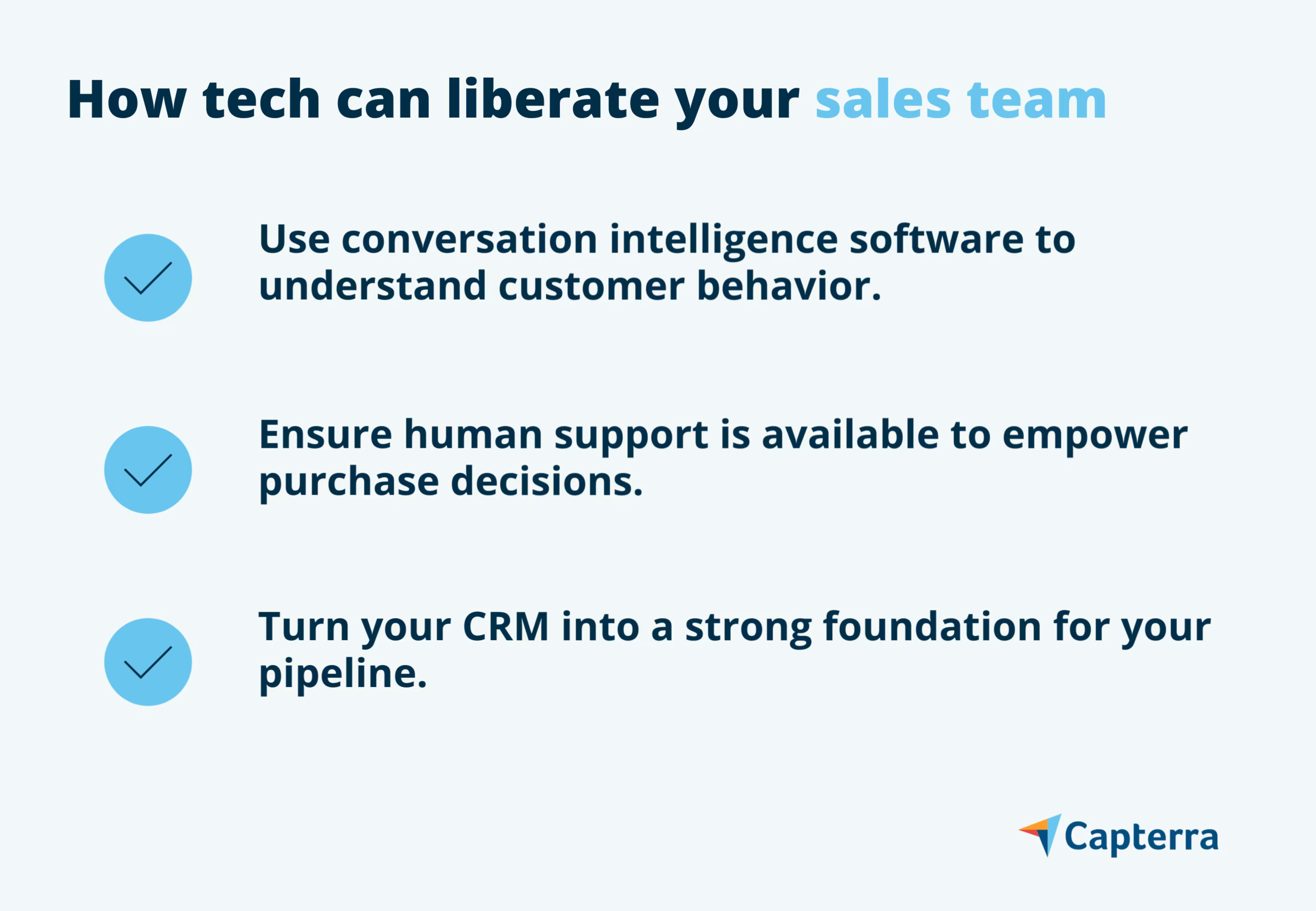Sales expert Matt Dixon shares insights into how today’s B2B customers make decisions and how tech can help sales.
Sometimes, all you need is a fresh perspective to shatter the status quo. Matt Dixon’s research-based methods have been helping salespeople, particularly those selling technology products in the business-to-business (B2B) space, base their selling strategy on real customer behavior and psychology rather than assumptions.
“We’re sitting on mountains of data. And in sales, you know the outcome: Whether the deal was won or lost, the size of the deal, and how long it took to close it,” notes Dixon.
“The irony is, despite all this data, sales is the land of hearsay, conventional wisdom, passed-down folklore, and personal opinions.”


Matt Dixon
Sales expert and bestselling author
Dixon takes a diametrically opposed approach, explaining, “I let the data and research speak to what the best salespeople are doing and the customers’ buying behaviors.”
3 big changes in today’s customer buying behavior
Dixon has observed three major changes in B2B customer buying behavior that directly affect the sales process.

1. B2B customers are doing their research long before they contact a salesperson
First, customers are doing their own research, even when buying complex or sophisticated solutions.
Dixon explains the implications of this: “They basically do all their research, create a shortlist of vendors, create an RFP, and then force the vendors to compete on price because the customer does all their due diligence and their research on their own about what problems they should be solving.”
This puts the salespeople in the tough position of selling on price—a situation they want to avoid.
2. More people are now involved in the buying process
The second big change is the expansion of the buying committee. In previous research, Dixon found that the average buying committee had 5.4 stakeholders. Today, he points to more recent Gartner research that estimates an average of 11 active members and up to seven occasional participants.[1] Contributing to this expansion is the use of online collaboration tools.
“You think about the implication of video conferencing and virtual selling on buying committee growth. There's no downside to sending the video meeting invite to everybody and then having them all show up for the demo or the sales call. And now, as a salesperson, you're really herding cats," Dixon says.
With more people involved in the decision-making, it increases the chances of someone objecting to the purchase.
3. No-decision losses are on the rise
The third big finding is that no-decision losses are increasing. Dixon’s research finds that between 40% and 60% of the average salesperson’s qualified pipeline is ultimately going to be lost to no decision.
“No-decision losses are deals that just evaporate. The customer ghosts you. You don’t know if they went with a competitor. You don’t know if they preferred their status quo.”
Matt Dixon
Sales expert and bestselling author
He adds that in the software-as-a-service (SaaS) market, much of the purchased solutions have become shelfware, so companies are reluctant to jump into the next SaaS product.
“We do know that a lot of firms are acting with tremendous caution. There’s a lot of budgetary scrutiny,” observes Dixon.
“That 40 to 60% was a number we pulled in the summer of last year,” adds Dixon, “and I think most salespeople, especially in the SaaS and tech markets, would say things have actually gotten a lot worse. I’m hearing no-decision loss numbers upwards of 80%, which is really staggering if you think about it.”
Fear of messing up trumps fear of missing out
What’s the psychology behind customers simply choosing not to purchase? Even today, many salespeople in these situations attribute it to status quo bias—it’s easier to stick with what you have. In response, they ratchet up the fear of missing out (FOMO) as a scare tactic.
About the best salespeople, Dixon says, “Challengers are good at breaking the mold of the status quo, which is very powerful in the customer’s mind. It’s always easier to stick with what you’re doing today, even if it’s not great. Customers will pass up on better opportunities just to do more of the same. So, we know that the status quo is a big enemy in sales. What’s surprising is that those FOMO tactics actually backfire more often than they work out.”
“Indecision, by definition, is not a decision. It’s a wasteland between wanting to take action and being able to take action,” says Dixon.
He adds, “These are customers who want to buy, but can’t buy. The question is why? What keeps them from moving forward is their fear of failure.”
Dixon suggests three possible explanations for the fear of failure:
Choice overload. The customer thinks, “Have I chosen the right configuration? The vendors put a lot in front of me: different partner integrations, different contract lengths, different use cases, professional services, DIY, you name it.” The customer looks at too many options and gets paralyzed with indecision.
Insufficient research. Customers may feel they haven't done enough research. Dixon explains, “They feel the next industry report, or the next analyst they talk to, or the next person in their LinkedIn network they consult will have all the answers. They want to avoid a situation in which they get surprised after the contract is signed, when some new piece of information comes to light that makes the purchase decision seem like not such a great decision. And then they get blamed.”
Expectations strain. These are the customers who feel they just won't capture the full benefits from the purchase. They won't realize the ROI, the cost savings, the revenue growth, etc. “What's interesting about this one,” notes Dixon, “is that customers don't blame vendors for that. They blame themselves.”
“The fear of missing out can be a powerful weapon when it comes to getting the customer to agree to change. But when the customer is already convinced that the status quo is not good enough and that they have to change, dialing up the FOMO is just using scare tactics to sell to someone who’s already afraid. But they’re not afraid of what you think they’re afraid of. They’re not afraid of missing out. They’re afraid of messing up," Dixon says.
/ Read more
61% of U.S. SMBs say they have buyer’s regret over a technology purchase in the past 12 to 18 months according to Capterra’s 2023 Tech Trends Report. Check out the report for more insights into what's causing regret for customers.
How SMBs can use tech to inform—and liberate—their sales team
As Dixon noted earlier, sales is sitting on mountains of data. The best sales organizations are taking advantage of modern technology to understand their customers. He shares some steps that sales teams can take to make the most of new technology.

Take advantage of conversation intelligence software
Twenty years ago, it would have taken dozens of people years to collect the insights needed to understand customer behavior, explains Dixon. Now, sales can pull recorded sales conversations, couple it with their CRM data, and gain understanding of customer behavior with great precision and great speed. And they can do it much more cost effectively with fewer people.
With these AI-powered tools, sales can answer questions like “What is it that our customers want? What are the insights we should be bringing to them? What are the ideas, the white space opportunities? Who are the competitors we're really battling with in the marketplace?”
Dixon advises further: “Put these sophisticated machine learning tools in the hands of salespeople. We're rapidly getting to a world in which you can query in natural language one of these engines that could pull millions of sales calls and data points from CRM and other revenue intelligence technology platforms and provide precise data, predictions, and suggestions.”
Provide the human support for a purchase decision
New advances like generative AI are fantastic tools to support the customer journey, but Dixon notes, “It still takes a salesperson to put their arm figuratively around the customer’s shoulders and say, ‘It’s going to be okay. We’ve got your back. I know when you look back on this decision, you’re going to say it was one of the best decisions you ever made as a business.’”
Dixon says that tech can free up organizations and salespeople from doing the work that really people shouldn't be doing at all.
"It really liberates the salesperson to use what people are best at doing, which is that EQ piece—making those connections with buyers on an emotional level," Dixon adds.
Build on the foundation of your CRM system
With all the video conferencing tools and conversation intelligence platforms, sales still needs a foundation to the tech stack. And that’s the CRM software.
As a category, Dixon believes CRM has to be the chassis on which the tech stack is built. Without that, without a single source of truth around prospects, live opportunities, and existing customers, everything else falls apart. You don't know what customers are looking for. You don't know why deals are closing or not closing. It's hard to forecast. It's hard to allocate territory or prioritize opportunities.
“Then there's so much we can layer onto that: revenue intelligence, tremendous forecasting tools, conversation intelligence tools, you name it,” adds Dixon.
Tech itself cannot drive behavior change
But tech isn’t the answer to everything. Dixon says sales organizations sometimes make a big mistake by buying technology and assuming that the tech will drive behavior change. Instead, you have to do the hard work of training and coaching your team, incentivizing them in the right way, and building the right sales culture.
"Technology is not a sales effectiveness pill. It is a phenomenal accelerator. It's a great stickiness tool, it's a great reminder. But there are no shortcuts to doing the hard work of behavior change and skill development with your sales team.”
Matt Dixon
Sales expert and bestselling author
Leverage your tech stack to reach customers
No matter what the external forces in the marketplace are, the best salespeople excel because they understand their customers and respond accordingly. Dixon’s research has traced the evolution of B2B customer behavior to help sales teams learn from the best in the field.
Dixon’s research has mapped the three significant shifts in customer buying behavior: Customers have already done their research before they contact a salesperson, they have more team members involved in the purchase decision, and, in these uncertain times, their fear of messing up will lead to no purchase decision at all.
Dixon advises sales teams to take advantage of today’s powerful modern tech to glean insights into their customers’ buying behavior. By building a modern tech stack with the CRM as the foundation, SMBs can gather the mountains of data and use machine learning to make sense of it with minimal resources and effort compared to past methods.
The final caveat to all this is that without the right training, coaching, and incentives, sales leaders can’t change their team’s sales behaviors. Technology is an enabler, but only when the salespeople adopt it and use it to understand their customers and give those customers the confidence to buy.
For more on sales team enablement, check out the following pieces:
